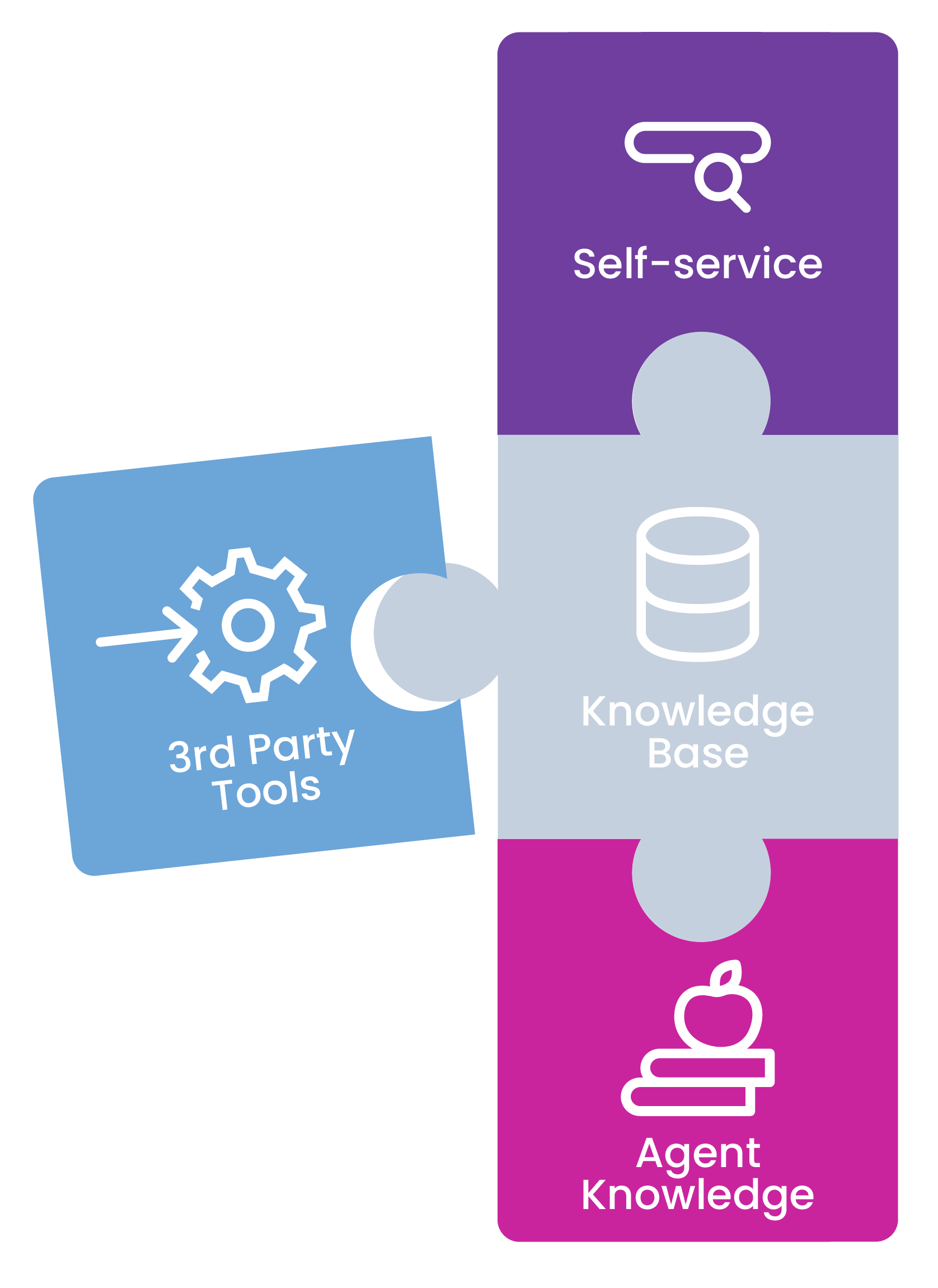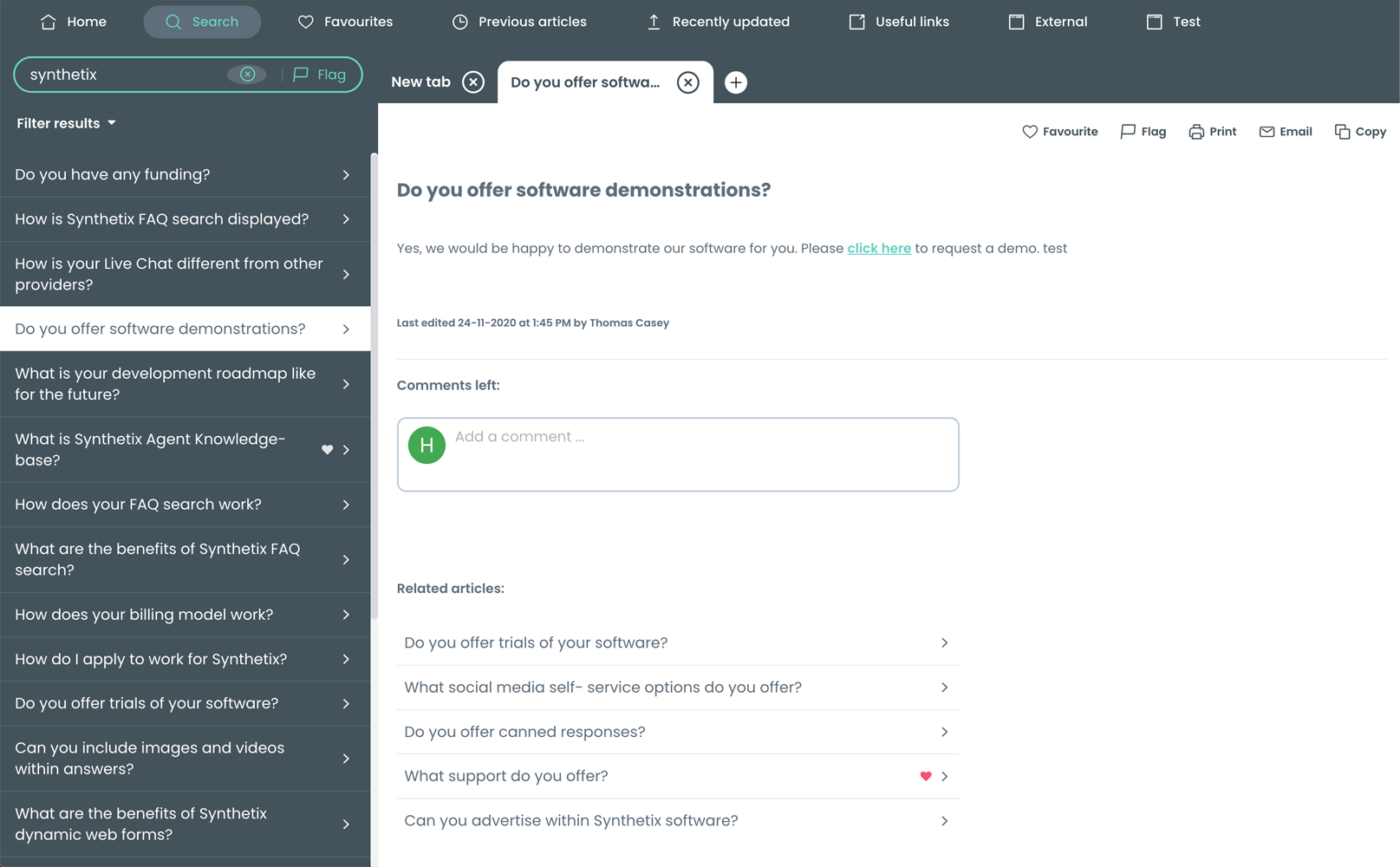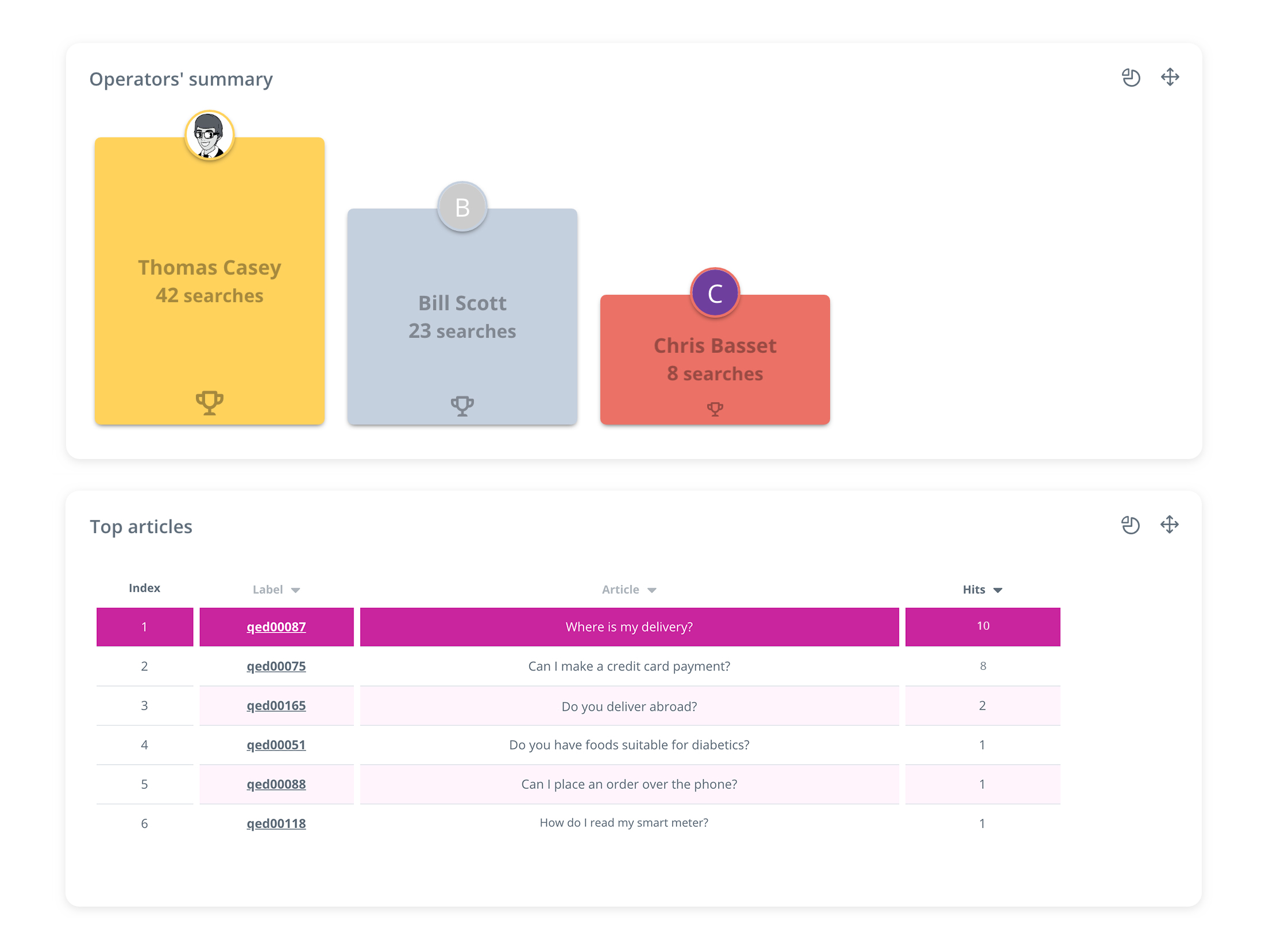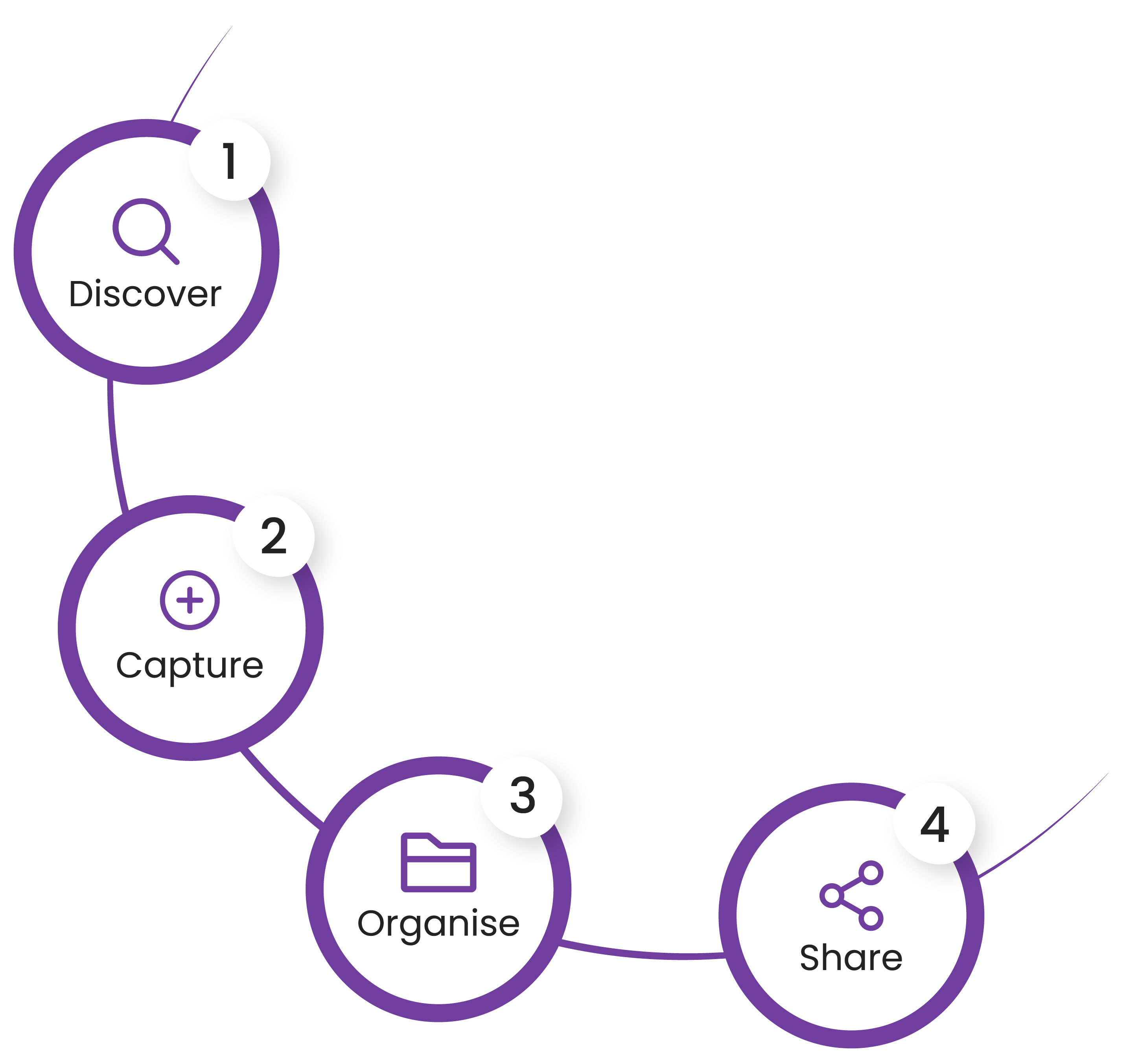Synthetix have the complete platform of customer service tools.
Book a demo of any of our products below
“If only HP knew what HP knows, we would be three times more productive.” -Lewis Platt
What Is Knowledge Management
Knowledge management is a practice used by a variety of companies to optimise their collective knowledge and the way is it used. It focuses on the process of identifying, capturing, organising, sharing and managing company knowledge.
Knowledge comes in many forms and can include:
- Data
- Information
- Experience
- Ideas
- Perspectives
In recent decades, a shift in digitisation saw a greater demand for knowledge management; organisations learnt that the controlled and optimised sharing of knowledge could contribute to achieving operational and strategic objectives.
As a key function, it is responsible for integrating people, processes and knowledge management tools and technologies to encourage the seamless flow of knowledge throughout a company. Knowledge management considers knowledge as an asset and can reshape business culture into one that is collaborate, transparent and promotes knowledge sharing.
The practice of knowledge management extends far beyond intranets and databases and helps businesses deal with both explicit and tactic knowledge.
Let’s discuss the differences:
Explicit Knowledge
This is the codified knowledge that can be found in company databases, documents, records and files. It is essential to business and simple to extract and share. Examples include policy documents or agent scripts.
Tacit Knowledge
Tacit knowledge is difficult to communicate and therefore hard to capture and share. It is usually derived from experience and practice and is unique to a business – which is why it is so valuable.
Tactic knowledge requires good knowledge management that handles it with great care, ensuring that nothing gets lost in translation.
Knowledge management seeks to extract explicit knowledge, unlock tactic knowledge and seamlessly distribute both to the appropriate people. This could include serving employees or customers via knowledge management technology such as CRMs, knowledge bases or customers self-service tools
What Is Knowledge Management Software?
One of the greatest challenges when it comes to knowledge management is knowing how to execute it. The best way to do this is by implementing knowledge management software that can help you deliver your knowledge management strategy successfully.
Another prominent challenge that businesses find is getting employees to embrace the discipline. Just like any new practice or change within the workplace there will always be some uncertainty. How do you overcome this? By making it easy for your employees to embrace – which is where good knowledge management software comes in.
Knowledge management software helps businesses simplify the knowledge management process by organising, storing and sharing knowledge in a sophisticated yet user-friendly way.
Read: The knowledge management system buyer’s guide.
A Knowledge Base for example, is a popular knowledge management tool that acts like a library of knowledge that can be accessed by your company and developed whenever is necessary.
Such knowledge management software can hold thousands of articles of knowledge. They are engineered using advanced search algorithms, categorisation and views to help companies save time and organise knowledge in a digestible way.
Machine learning principles and Natural Language Processing (NLP) make finding answers simple. An employee can type a question into the search bar and a series of relevant results will be displayed. A knowledge base will learn over time based on user interaction and results to optimise the answers given. These results can easily be edited, developed and shared to assist the successful execution of knowledge management.
Employees become advocates of such software, not only is everything available at the click of a button, all in one place, but they are given the freedom to learn and retain crucial knowledge before it is potentially lost with employees that leave a company.
Find out how to effectively roll-out internal knowledge base software, here.
What to Look for in Knowledge Management Software
Any good knowledge management strategy is centred around effective knowledge management software
But what should you look for in knowledge management software?
Implementation and Integration
Effective knowledge management software integrates seamlessly into an existing ecosystem of products.
The knowledge platform should fit in with current processes, workflows and other knowledge and customer service software, such as:
- Internally-facing applications that gives your team access to your company’s wider information, assisting them when talking to customers. This allows agents to quickly pull answers from one reliable, centralised source resulting in an improvement in First Contact Resolution (FCR) and Average Handling Times (AHT).
- Customer self-service software, helping customers answer their own questions online. This reduces the overall number of inbound contacts for contact centres to process.
To integrate with 3rd party systems such as email management tools or CRMs, knowledge management software should be built on open RESTful APIs. This ensures compatibility with most 3rd parties, providing you with a full, ‘360 degree’ implementation of shared knowledge into your organisation and holistic analytics.

For more on essential knowledge management tools, click here.
User-friendly Interface
Consider software that offers a practical agent desktop or web interface for you to choose from. Software that includes user-friendly features such as note-taking, categories, views, internal tabs for quick viewing and customisable interfaces can help employees navigate software better, giving them the right knowledge quickly.
Such knowledge management tools can increase agent efficiency, offering relevant answers and optimising the time and accuracy needed to resolve customer queries.

Natural Language Processing
Knowledge management software that uses natural language processing (NLP) and AI-powered machine learning principles can enhance the quality of the answer that is delivered to the user (whether that’s an employee or customer).
Choose software that understands naturally phrased questions, can learn and uses search intent; taking into consideration the keyword, intent, grammar and popularity of the question to deliver the most relevant result.
Analytics
You can’t improve what you can’t measure. Without comprehensive analytics, companies are working in the dark, blind to the effectiveness of the content in their knowledge base. Reporting and analytics suites help businesses learn and develop their knowledge management and should be central to any knowledge management product. Popular queries can be pulled to develop content around, whilst agent performance reports can be produced to measure efficiency.

Why Is Knowledge Management Important?
Knowledge Management concentrates on what is known and not documented. An approach that can help enhance company culture, remove siloed knowledge and by doing so, increase organisational efficiency.
We have significantly more knowledge stored in our brains than we do written down. All too often this becomes a problem for businesses when their long-term employees leave – their knowledge leaves with them. Years of accumulated tacit knowledge is lost just like that. Recovering and reteaching such unique knowledge proves incredibly time-consuming, costly and often impossible.
Another risk that companies face by not adopting knowledge management, involves knowledge silos. In a time when flexi and remote working is becoming the new norm and teams are often dispersed across locations, there comes a lack of sharing and collaborative culture – and this is how knowledge silos are formed. Knowledge management aims to eliminate knowledge silos within organisations so that information is accessible to the right people whenever they require it.
Unless it is encouraged, teams don’t always communicate. If the value of knowledge sharing is clear to employees and knowledge can be seen as an asset, then it will eventually become part of the culture.
Without knowledge management your company could miss a lot of invaluable, irreplaceable knowledge, resulting in wasted resources, high costs and frustrated employees and customers. It’s all about knowing what your business needs to know and making this available to the right people in the best way for them.
Benefits of Good Knowledge Management
How can knowledge management benefit your company and customers?
Improved Efficiency
One of the biggest impacts on business when it comes to knowledge management, is improved efficiency – particularly at an operational level.
Organised, accessible and digestible knowledge makes for faster decision making and therefore less time spent dealing with routine questions. The impact of this can be seen on the bottom line – a study by Gartner revealed that an 18% reduction in support costs occurred by encouraging knowledge management.Knowledge management means no more waiting around for that email response from HR, which you will then have to reply to a couple of times before eventually reaching an answer. It also results in significantly less time spent training and onboarding new employees, on average a 30% reduction in agent training times. This is because the internal knowledge that has already been captured and stored is permanently available for future starters at any time.
Customers can benefit from your knowledge management too, existing in the context of self-service, customers no longer need to wait for the answer to a FAQ, they can solve it themselves using the knowledge stored in your knowledge base.
Greater Accuracy
It’s perfectly normal for humans to make mistakes, but without knowledge management, companies run the risk of the same mistakes happening time and time again, whether it’s years apart or in different departments. The beauty of knowledge management is that resolutions can be stored and made available to prevent this from happening.
Knowledge management also allows for consistent information to be shared which is particularly important if you are communicating with customers. Providing inaccurate, inconsistent information to customers can prove problematic but easily avoided through knowledge management. All it takes is a simple search using a knowledge management tool and standardised company information and policies are available to consult.
Empowered Employees
Employees just want to do their jobs. So, when obstacles are put in the way of them fulfilling their tasks, such as lack of information or delays waiting for access to information, it can become incredibly frustrating for them.
In fact, a recent study revealed that 51% of participants felt frustrated at the inability to access a former colleague’s institutional knowledge, while 25% said they were overwhelmed. The impact of which can include low staff morale, subsequently affecting productivity.
Making knowledge available to agents who need it or wish to learn more can empower them. When given quick, easy access to the right information, without having to ask permission first can boost productivity and staff retention.
Customer-facing knowledge management tools, otherwise known as web self-service automate routine questions, removing the mundane from agents’ roles. As a result they can deal with more complex customer issues, promoting staff morale.
Satisfied Customers
The internal benefits your company experiences from adopting knowledge management can positively impact your customers too, enhancing the service and experience you provide them.
When knowledge is optimised effectively companywide, stored and shared in a knowledge management tool such as a knowledge base, customers can benefit from quick access to information such as return policies, how-to guides or troubleshooting videos.
20%
Did you know that 20% of routine questions can be handled online using knowledge management tools?
Source: Synthetix research
Self-service software integrates with your company knowledge base which, by utilising a filtered view, grants customers access to vital answers to their routine questions. Customers, who prefer to self-serve can resolve issues themselves, rather than having to contact a company representative directly and therefore has an enhanced experience – reflecting positively on NPS and CSAT ratings.
Cultural Shift
Embracing knowledge management within a company can have huge positive effects on teams. Whilst this culture shift won’t happen overnight, companies that embed knowledge management eventually experience a transparent knowledge sharing culture.
Not only does a knowledge sharing culture encourage collaboration across an organisation, producing a new array of ideas and innovation, it also helps to reshape employees’ perceptions of knowledge. Instead of viewing knowledge as a thing we all have in our heads, employees begin to see knowledge as an asset. They appreciate that just like people, finance and brand are valuable assets that require management and specialised systems , so does knowledge.
Get the most out of knowledge management with these 12 best practices.
Knowledge Management Process
The overall knowledge management process doesn’t need to be complex or lengthy. It does however require specialised technology to ensure smooth execution.
There are several ways that the knowledge management process can be broken down, but in its simplest form it can be categorised into 4 parts: discover, capture, organisation, share.
Let’s unpack these 4 steps further.
Discover
‘We only know what we know when we need to know it” – Dave Snowden
The discovery stage of the knowledge management process is responsible for finding out what exactly a business needs to know and where knowledge already exists. This generally includes explicit knowledge that is already documented, but perhaps in a fragmented way.
Knowledge management will extract this explicit knowledge through the data mining of company documents, intranets and other records. Good Knowledge Management software will be able to semi-automate this time-consuming but necessary process.
Capture
As the name suggests, this step focuses on the capturing of knowledge that is not documented. It concerns turning the tacit knowledge into explicit, consumable knowledge.
This is arguably the most challenging and time-consuming step of the knowledge management process; knowledge management must capture the knowledge that resides in employees’ brains, which has become second nature to them and therefore difficult to communicate.
There are a number of methods that Knowledge Managers use to capture tacit knowledge including:
- Observation
- Interviews
- Surveys
- Retrospect (reflection meetings that take place after the completion of a project)
- Knowledge harvesting (often involving senior employees)
Organise
Once knowledge has been discovered and captured, knowledge management must unpack and process it in a way that makes it consumable for all. This requires deep analysis to see how knowledge can be best organised, displayed and incorporated into the company.
The organisation and accessibility of knowledge is the very essence of knowledge management. Therefore, it is crucial that this step is conducted successfully.
Most businesses use knowledge management software to organise and store their knowledge. Purpose-built systems order and display knowledge effectively to remove the fear, uncertainly and ambiguity surrounding knowledge.
Share
Making the right knowledge available to the right people at the right time is key. Without this step, a company would have masses of vital knowledge intricately stored and organised with no way to access it.
Knowledge sharing pulls all the other knowledge management steps together. It takes all the acquired knowledge and communicates it throughout a company. Some Knowledge Management Software even gamifies aspects of knowledge sharing, allowing employees to submit articles for approval, which if used lets others comment on and interact with.
Knowledge can be delivered via presentations and meetings but the most effective way to share it is through knowledge management software, allowing knowledge to be consistent and available on demand depending on who you are in the company.

To find out more about the knowledge management process, click here.
Conclusion
Mastering knowledge management can be challenging, it’s an elusive discipline that deals with complex knowledge types and intricate processes. But if your company objectives are based around efficiency and wish to encourage a more transparent, collaborative culture then knowledge management is fundamental for you.
If you would like to explore knowledge management further, you can read more here, or
if you’d like to discuss your organisational needs.


